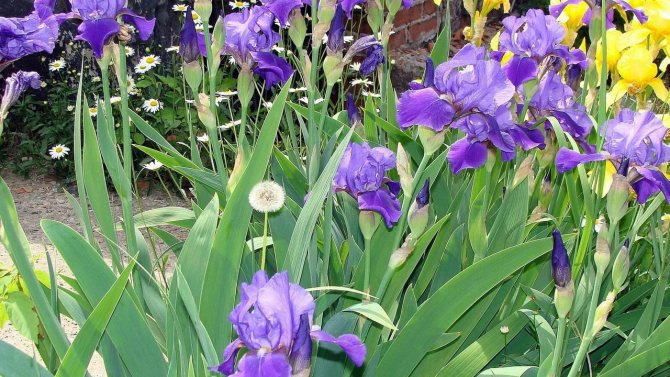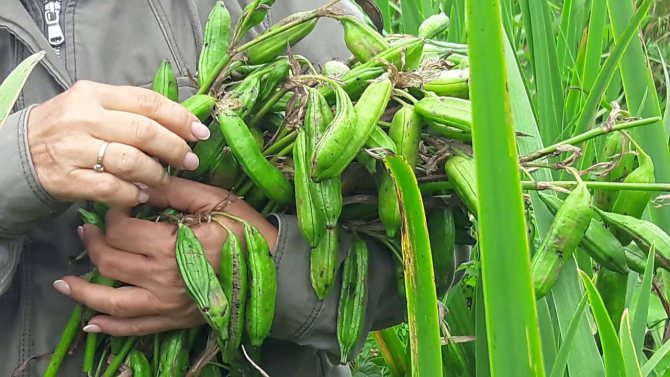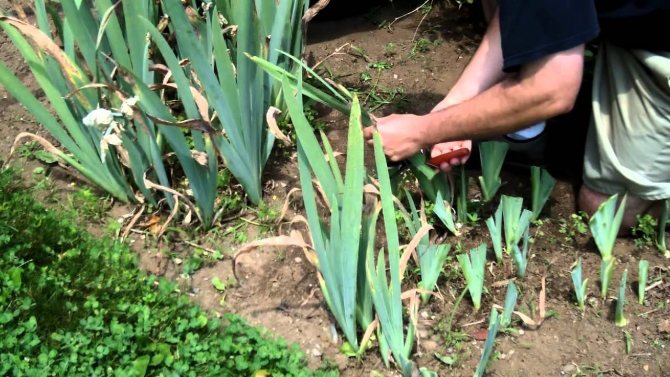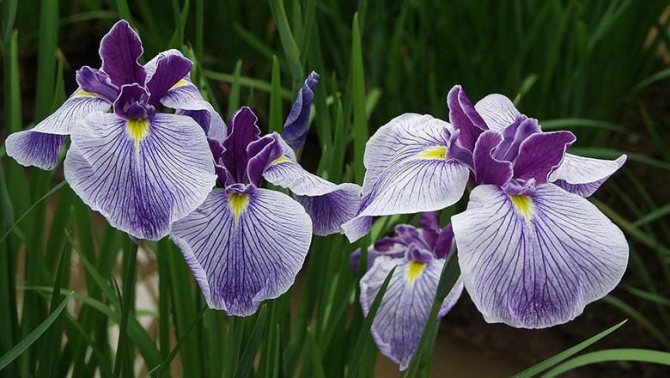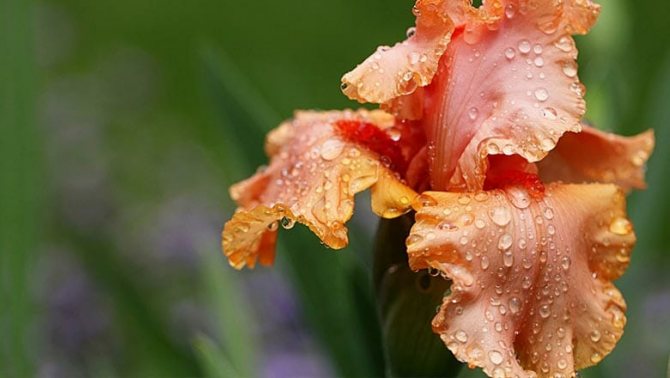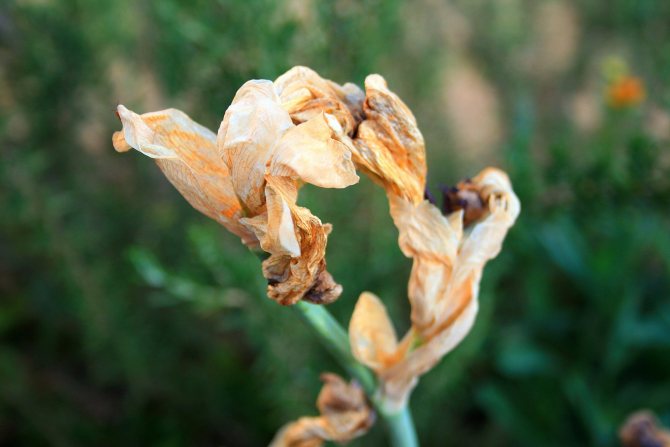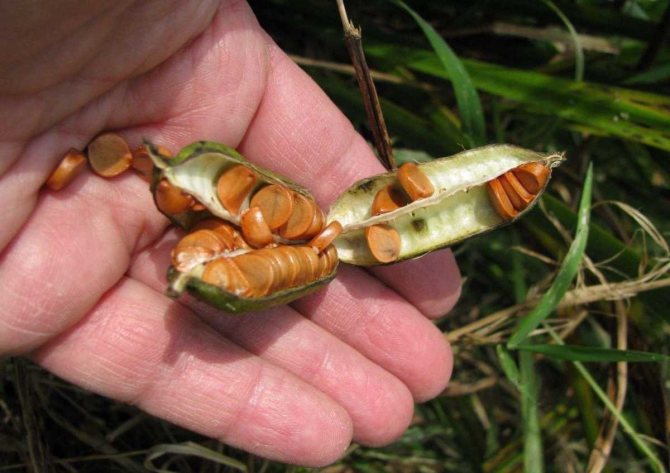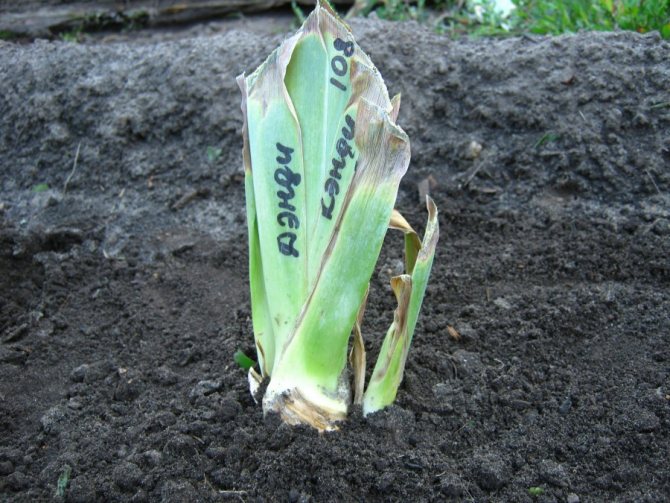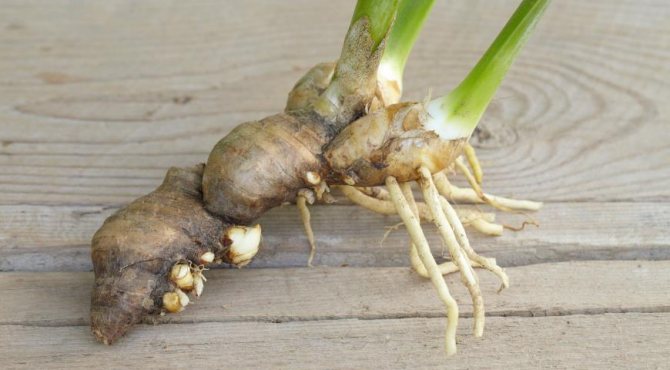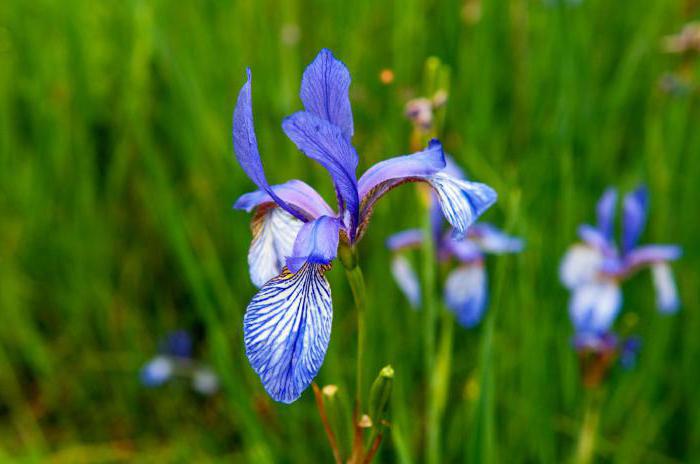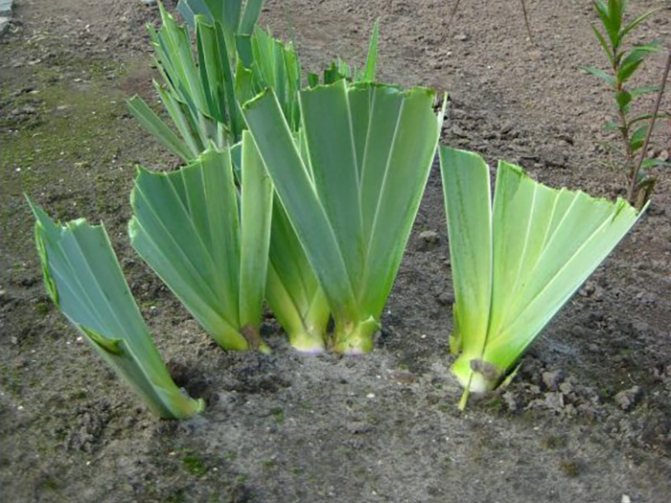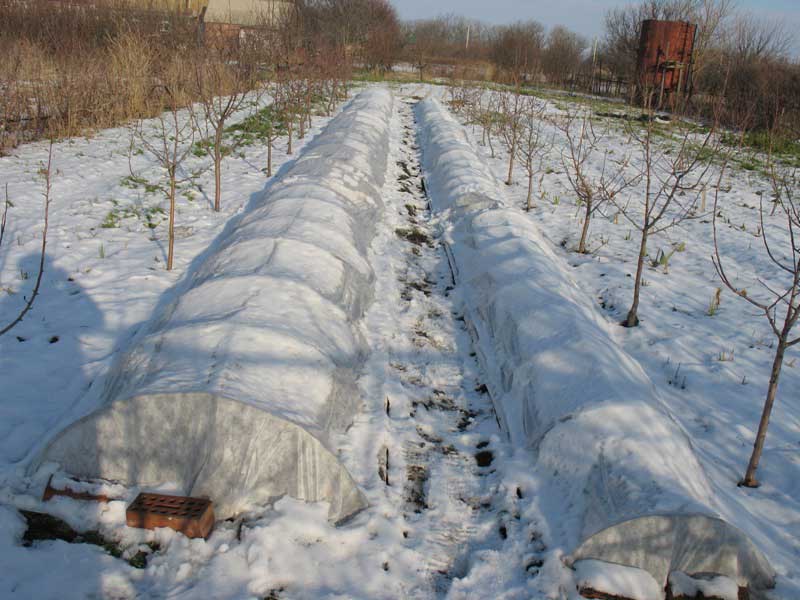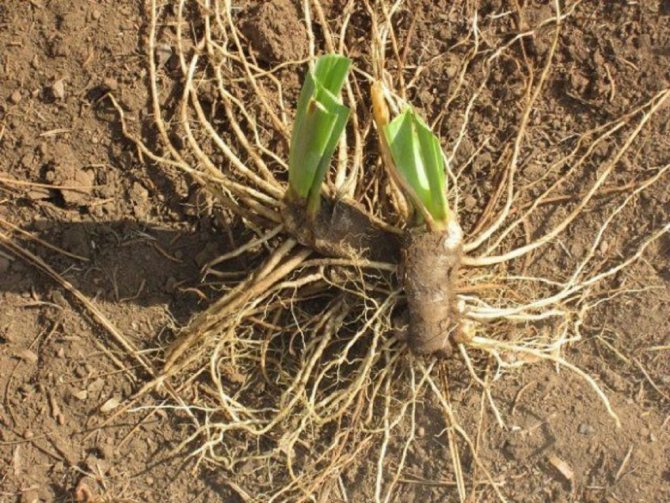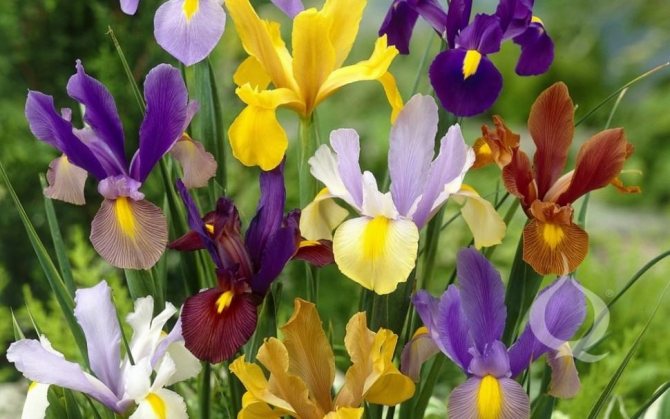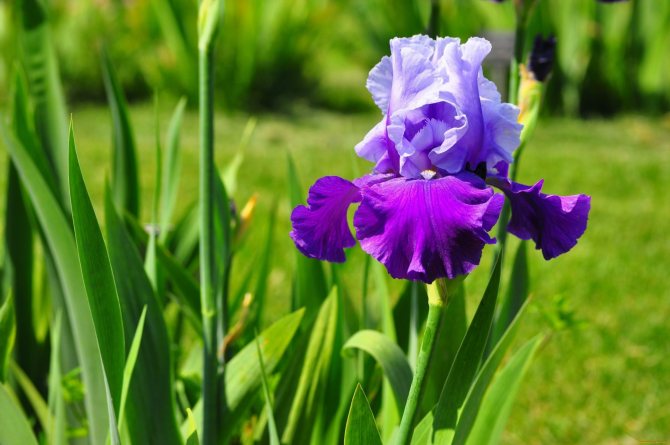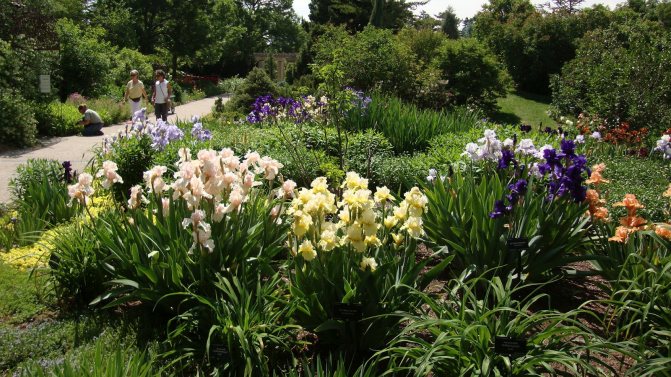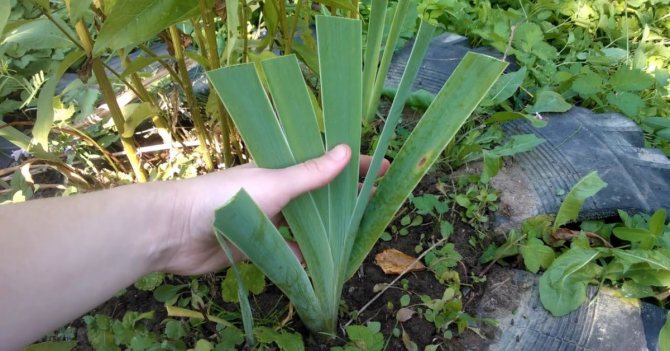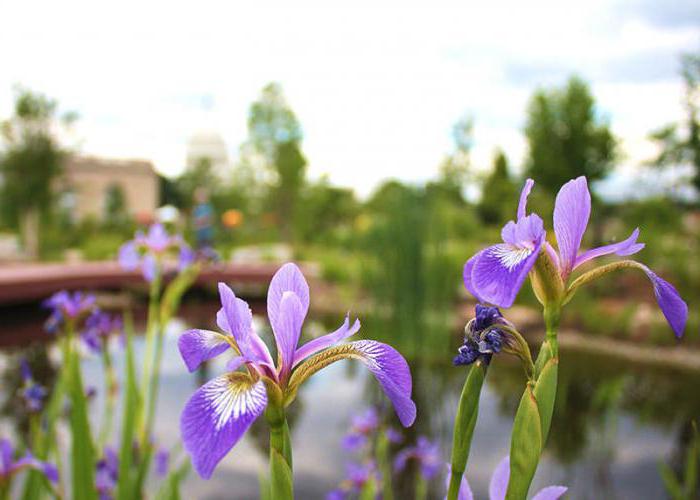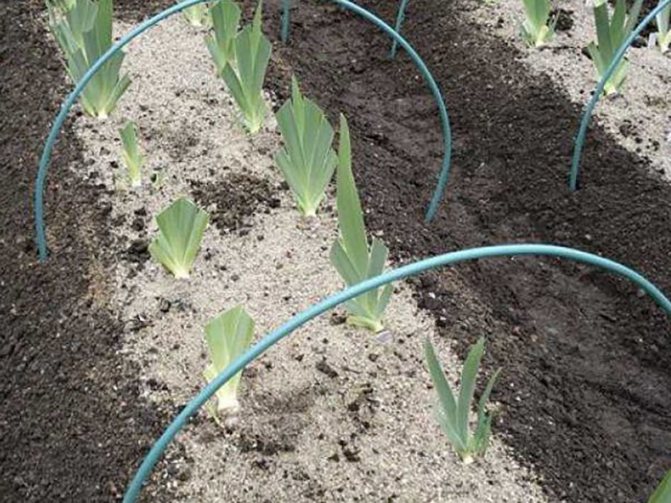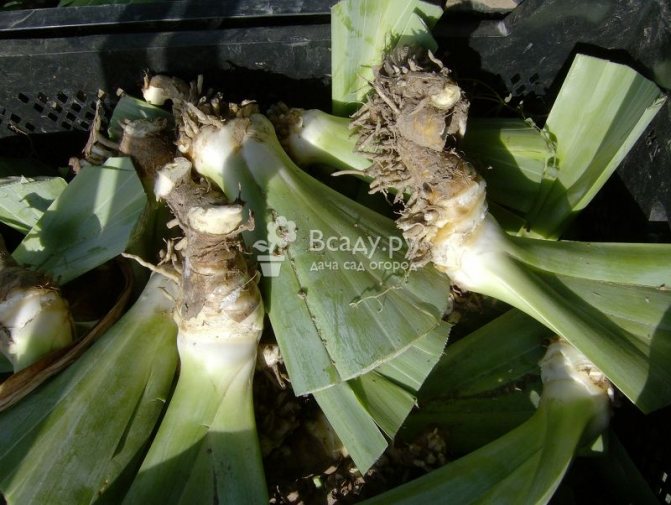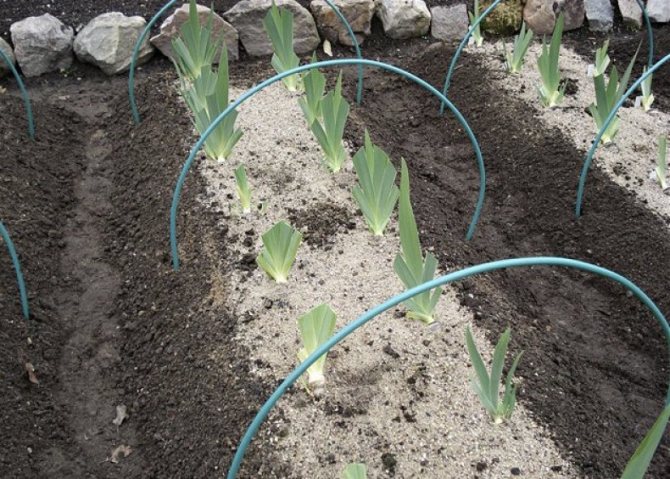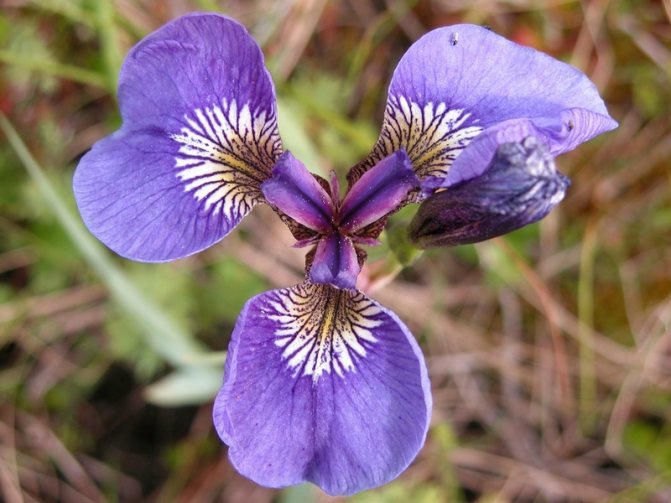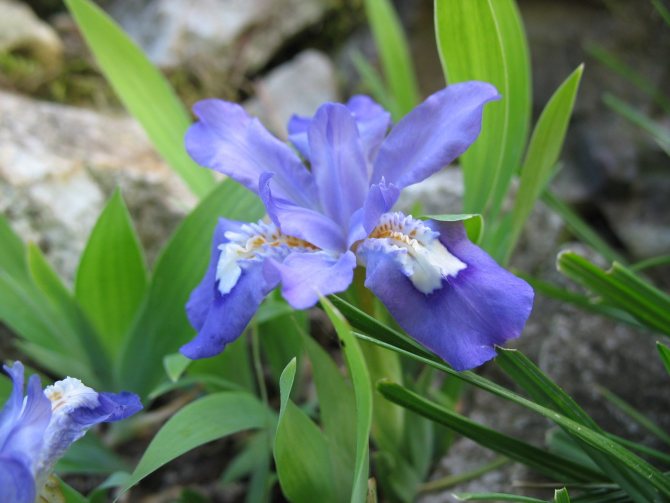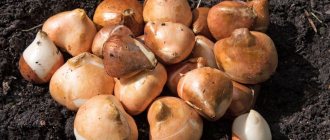Any novice gardener wants to properly care for a perennial plant, especially a flowering one. How to prune irises? When to do it? Should you leave a fan of leaves?
Iris is often called the iris. Iris flowers have been grown for a very long time and now there are more than 1000 varieties of plants with different bizarre shapes and colors of buds.
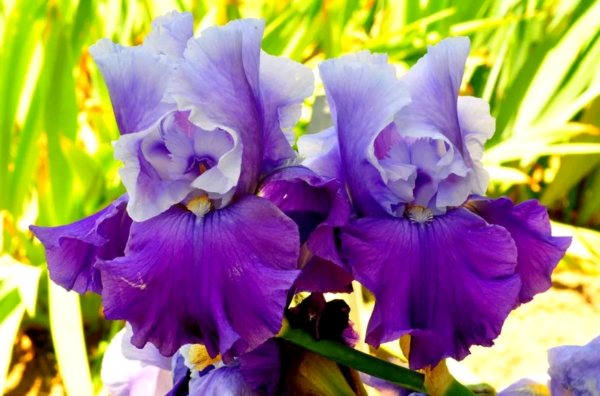
It is a perennial plant and requires some care to delight every year with beautiful flowers and great flowering. One of the important elements of caring for a flower is how it is pruned correctly. Over the years, gardeners have learned how to best care for flowers.
How to prune irises correctly? When should you do it? Do you need to leave a fan of leaves?
Irises are pruned several times per season, depending on the indicators:
- The fan of leaves is yellow, spotted;
- The end of the flowering period;
- Autumn period and frost;
- Iris variety.
Let's consider the most important periods when it is necessary to trim irises. The tips and rules of care in this article will help you properly care for the plant.
Iris care after flowering
Irises are incredibly beautiful flowers. They decorate flower beds, but at the same time, after flowering, they require care. For example, flowers and stems should be removed. However, you should be more careful when pruning foliage so as not to harm the roots.
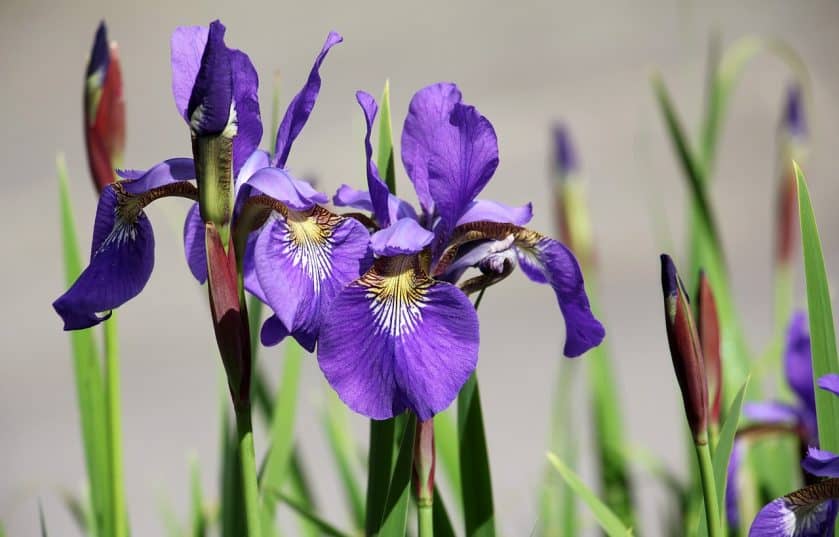

Irises
Removing individual flowers, stems and foliage
During spring and summer, irises should be pruned. It is recommended to use special garden tools to remove dried plant parts. For example, pruning shears or scissors with sharp blades. Poor pruning can severely damage the plant.
So, to remove wilted flowers, you need to prune along the peduncles. More specifically: cut off the receptacle and the bud. At the same time, departing 2 cm from the selected bud. When the stem has completely bloomed, you should cut it two centimeters above the ground. Bushes should be checked for dried flowers once a week. This is quite enough.
Important! Unbroken buds cannot be cut off.
Next comes the question of removing leaves. They should not be removed. They store and conduct nutrients and solar energy to the roots. This will be especially useful in the future in the winter season. In particular, the leaves contribute to the landscaping of flower beds, play the role of decor. The exception is yellow and dried parts. You need to get rid of them.
Features of pruning some varieties
Individual iris varieties should be prepared for winter in different ways:
- in rhizome irises, dry and wilted leaves are removed only if necessary;
- for exotic varieties of irises, the foliage should be removed in half and only at the end of August;
- bulbous varieties require complete cutting of foliage and tops before winter.
If you take proper care of irises, prepare them for winter in time, then in summer you can enjoy the lush and long flowering of the plant.
How to get iris seeds after flowering
How to prune an orchid after flowering: options at home
As you know, many people breed irises by dividing rhizomes. This is not the only way. Seed planting is no less popular. When the flowering is over, you need to pick one bud and wait. Time is important for ripening.
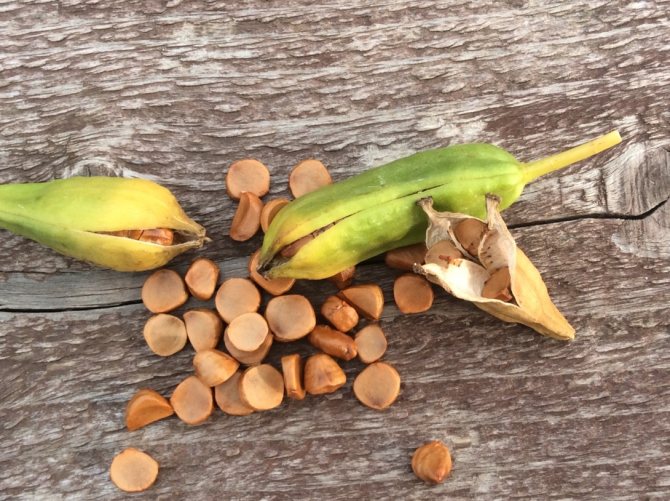

Seeds
Seed collection and germination
After a while, ripening is completed.Further, you should not overlook the process of opening the ovule. Collect seeds. Otherwise, the plant will shed them on its own.
Note! Most often, iris that is grown from seed does not have all the parental characteristics. Therefore, the option is not excluded that the color of the petals will be different.
The main rule when germinating seeds is to maintain the temperature. It should be roomy. The place where future sprouts are located is dry. Before sowing, it is better to keep the seeds in the cold, and then soak them in water for two days.
When to prune irises after flowering
Flowers such as irises require care after flowering. With its constant observance, the flower beds will definitely delight the eye. One of the most popular questions is the iris pruning process. If necessary? How often? How is it correct? When?
Do I need to trim faded irises
When to dig out hazel grouses after flowering and how to store before planting
Irises have faded, but in reality few people know what to do with them.
After all, this is a common question that torments gardeners. The answer is simple: it is necessary to cut the plant. The reason for this is the ripening of the seeds, which soon begin to crumble. The process is called self-seeding. If you do not control this phenomenon, then the site will quickly become overcast with flowers. Then all beauty will lose its meaning.
Important! Cutting dry and dull buds is also recommended. They simply spoil the aesthetic appearance of the flower bed. In addition, they take up a significant amount of energy.
When to prune iris leaves
When to dig up daffodils after flowering
Iris leaves are an important part of the plant. They store many minerals. They also serve as a conductive tissue. So, for example, solar energy and oxygen enter the plant. Therefore, experts do not recommend cutting them in the summer. Without them, the flower will suffer and possibly freeze. The best time for pruning is autumn, a few weeks before frost.
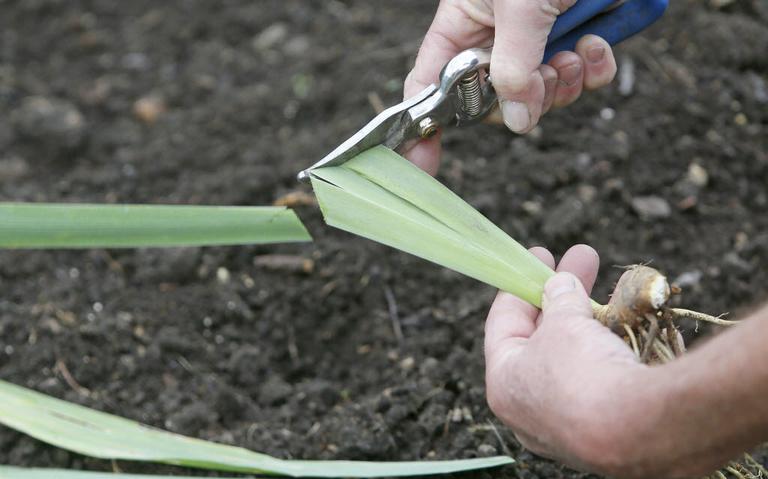

Pruning iris leaves
When and how to prune irises in the fall
Of course, you also need to know when to trim the irises.
The first step is to determine what autumn is in the region in a particular year. The pruning time depends on this. Most often, the process falls in the middle - end of October.
This is a measure that is necessary for the plant, because if prevention is not followed, insects or pests will lay larvae and eggs. Then in the spring the flower bed will be in a deplorable state. It is advised to cut the leaves in the form of a cone so that water does not accumulate. Otherwise, mold may appear, for example, widespread bloom - a type of mold, expressed by a pale green bloom.
Tips & Tricks
If you want the dacha to indulge in beautiful blooming irises next spring, you need to listen to the advice and tricks of experienced florists for caring for them:
- if the foliage of the irises has turned yellow, without waiting for the cold weather, it is worth pruning it earlier;
- sometimes you can do a semicircular pruning on the foliage to decorate the flower bed, while the roots will continue to accumulate nutrients;
- if a lot of snow is expected in winter, it will be the best shelter for wintering plants;
- when planting in divisions, their upper half should be well illuminated by the sun's rays;
- growth stimulants for killer whales are not needed;
- foliage and stems collected after pruning should be burned away from the site due to the fact that insects like to hatch their caterpillars in them.
Many gardeners love irises for their uniqueness and variety of shades. Unfortunately, they do not bloom for long, but after the completion of the ejection of flowers, they can be admired for a long time.
Top dressing of irises after flowering
Irises respond well to fertilizers. After their introduction, they bloom more beautifully and magnificently. The risk of disease is reduced. At the same time, it is important to correctly select organic and inorganic substances.For example, these plants respond positively to potash fertilizers, as well as phosphorus ones. It is important to feed the flower beds in time. It is worth making 3 top dressing per year: 2 in spring and 1 in autumn.
Important! All fertilizers are applied before frost begins.
Fertilizers for lush iris bloom next year
Further, what types of fertilizers should be introduced to irises, depending on the season, about their measure and necessity.
Autumn fertilizers
They are applied three weeks after flowering. In this case, the flower is already dormant. Then, the growth of young roots occurs, so feeding during this period is necessary.
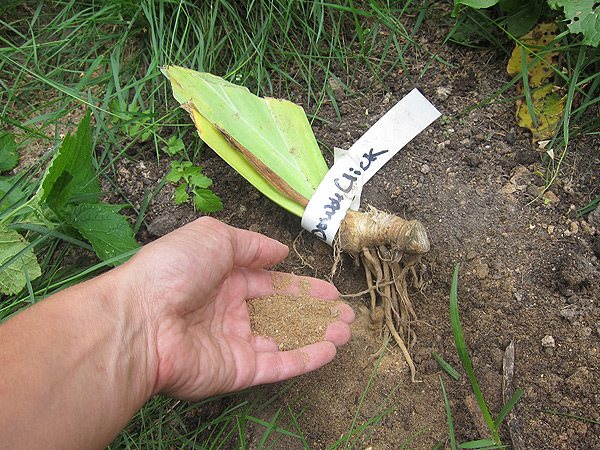

Fertilizing irises
In early September, flower beds are fertilized with a potassium-phosphorus composition. Be sure to observe the ratio 3: 2. Other feedings are also needed: potassium salt, superphosphate, organic additives. For 1 m², you need to take 55 g of superphosphate and 25 g of salt. It is important not to forget about the proportions, to observe them.
Note! It is strictly forbidden to feed irises with fresh manure, as this will provoke the appearance of fungus, other dangerous bacteria and diseases, as a result of which the flower will definitely not receive the necessary substances. As a last resort, humus will do. It will have a positive impact on the culture. It must first be diluted with water. Proportion: 1 kg of manure per 10 liters of water.
The above fertilizers will not save you from pests. In this situation, it is enough just to spray the flower beds with Bordeaux liquid. So they will be reliably protected until the arrival of spring.
Important! Careful use of fertilizers will help avoid unfortunate consequences, including damage by viruses, insects and bacteria.
Spring fertilizers
Active growth occurs in the spring. To accelerate and maintain it, it is worth introducing fertilizers.
The very first feeding takes place immediately after winter after the snow melts. It is necessary to include the same potassium-phosphorus, as well as nitrogen fertilizers. Nitrogen supplements are especially needed in the early period. However, they are recommended to be introduced no later than July. Their need is for the plant to grow stronger, gain strength, and slowly prepare for reproduction. But here the proportions change slightly and are 2: 3: 2.5. The main thing is not to overfeed the beds, otherwise there will come a period of deposition of minerals - fattening. For flowers, this is fraught with consequences.
For your information! Phosphate fertilizers take place if the soil is warmed up well enough. Otherwise, it will lead to the deposition of substances, and in the future - to the poisoning of the soil and grass.
For special protection against insects and other dangerous pests, gardeners recommend covering the soil with wood ash. Consumption is 2 tbsp. spoons on a flower.
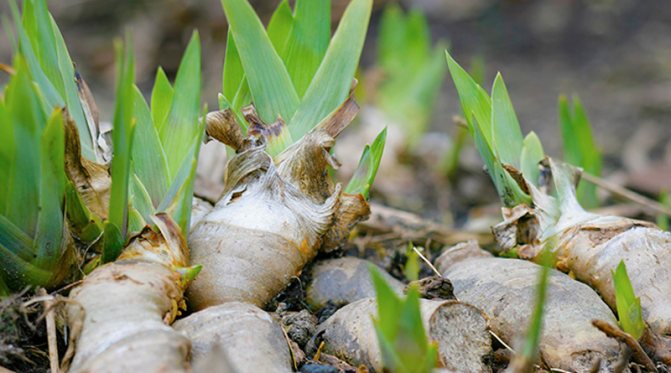

Iris rhizomes
Irises planting and care in the open field
In the fall, you can and should carry out the following work on the care of irises and their preparation for winter:
- pruning;
- top dressing;
- transplant (if necessary);
- shelter for the winter.
Each of these procedures will be described in detail below.
In different regions, the thickness of the shelter and its layer depend on the specific climatic conditions. Therefore, one should take into account the nuances of preparing a culture for winter in different regions of our country.
When the irises have bloomed, the main care is watering if necessary, several types of pruning and autumn feeding.
Watering mode
Additional hydration of irises is required in case of dry summers or lack of moisture during the flowering period. When the plant fades, watering is undesirable - during this period, there is an accumulation of dry matter in the roots or in certain species in the bulbs. Excessive moisture leads to water retention in the root system.
The first pruning of irises is done after the flowers have wilted. For convenience, use garden shears and remove the inflorescences with a receptacle at a distance of 2 cm from the bud. In order to remove wilted flowers in time, the bushes are checked 2 times a week. If in the future it is planned to plant with seeds, then several flowers are left for the ovary of the seed capsule.The flowering shoot is completely removed after flowering, leaving 2 cm from the soil surface.
Sometimes winters with little snow and low temperatures provoke freezing of even frost-resistant varieties. To prevent this, they are preparing for the winter. Old flowers, whose rhizomes protrude from the ground, are covered with a layer of soil and 10 cm of mulch, peat or sand on top.
- Be sure to cover young, transplanted plants in summer.
- If the weather is changeable: either a cold snap, then a warming, they are in no hurry to cover the irises.
- A thick layer of cover can cause the roots to decay.
- The flower for the winter is covered with a layer of spruce branches or similar material 10-15 cm in height.
- In the spring, they do not rush to clean the shelter so that frost does not damage the plant. But to raise it so that the flower does not sputter is highly desirable.
Some varieties of irises are dug up in summer to be planted in the ground in autumn or spring. In central Russia, the timing of planting in the fall depends on the onset of a cold snap. The time when planting bulbous irises is chosen dry, warm, during the Indian summer. More often it is September, early October, the main thing is that at least 3 weeks remain before the establishment of the freeze. Then the plant bulbs will have time to give small roots and will be ready for wintering.
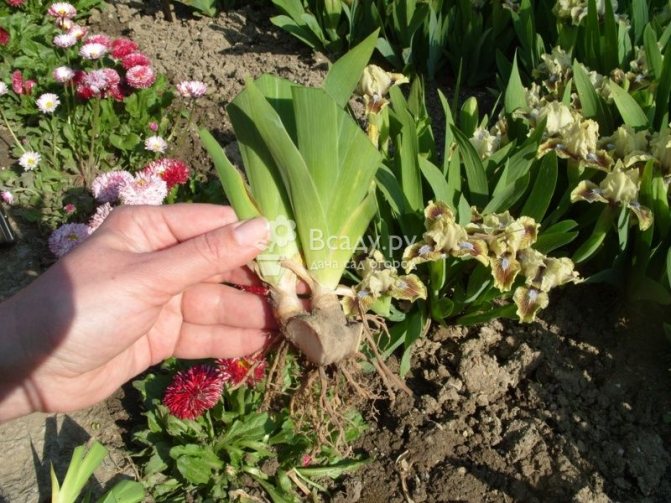

Irises planting and care
A properly planned plot is already half the success when breeding irises. In the event that the groundwater comes too close to the surface, the soil must be provided with a layer of drainage material, and it is even better to raise the flower bed itself to a height of 15 cm. There must be enough sunlight in the planting site, because irises do not like shadows and are bad bloom in such conditions.
Depending on the quality of the soil, organic (ash, humus from the compost pit) and nitrogen-containing mineral fertilizers (nitroammofosk, azofosk) should be added to it, then loosen, dig up and build a bed of suitable size with a slight angle of inclination to the south side. As for manure, it is best for them to feed the soil a year before planting.
Irises are not very demanding on crop rotation, but they still need to be replanted:
- Siberian irises and Kempfer's variety - 10 years after planting;
- Hybrid varieties and breeding subspecies - after 5.
When choosing a new site for planting, you should know that during this time the iris bushes can grow significantly and require a larger area. If you refuse to transplant, the plants will experience a lack of nutrients.
Experienced gardeners recommend planting irises in summer. This period is best suited as the kidneys begin to clog. They go to winter with fully formed rudiments, from which new flowers will appear in the next season.
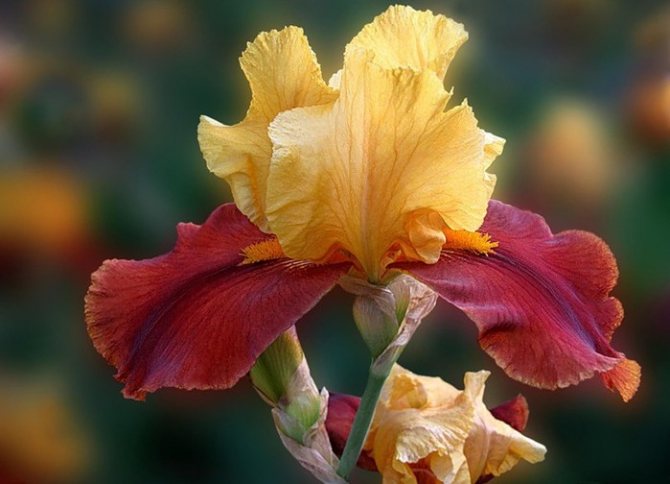

It is advisable to dig up the most delicate varieties of irises, which include some modern Japanese hybrids and leave for the frost period in a cool and dry place, since at temperatures below 8 degrees they can freeze or even die.
Transplanting irises after flowering should be done only if the roots have already grown new links (annual processes on the rhizome), but the flower bud is not yet completely tied. An annual link with a diameter of up to 2 cm and a length of up to 3 cm is called a landing unit.
It should be separated from the iris with a knife, without digging out the bush itself. Further - to shorten the leaves by one third and cut the rhizome, leaving about 10 cm of its length. The active growth of a young seedling in a new place will begin in 1-2 weeks, just when a new bud begins to form and the layers take root firmly.
When planting irises in the autumn, you need to choose plants that have already well developed roots, and the flower bud has reached a length of about 6 cm and a diameter of 2 cm.If the weather is favorable: there will be no prolonged rains or too early frosts, the irises will quickly take root and delight you with flowers next year.
It is very important to consider that the base of the root of a properly planted plant should be level with the ground. The ground should be compacted so that the leaf fan remains upright when gently pushed with the palm of the hand.
The size of the hole depends on the diameter and length of the rhizome. At its bottom, a special mound is built, where the roots are placed. Further, the seedling is slightly pressed, covered with earth and watered. The next time it is worth moisturizing the irises only after 4-5 days. In intense heat, plants need to be shaded. This can be done by building a twig frame and covering it with rags or straw.
These flowers need the same care as all other perennials:
- systematic loosening of the soil in the beds for air and water access to the roots;
- timely weeding (ideally manual);
- seasonal nitrogen-containing and complex fertilizing;
- regular watering in dry weather once a day, with normal air humidity - two to three times a week;
- prophylaxis against parasites and treatment of diseases (0.3% copper oxychloride, 1% Bordeaux mixture once a month in a rainy season or every three in a dry season).
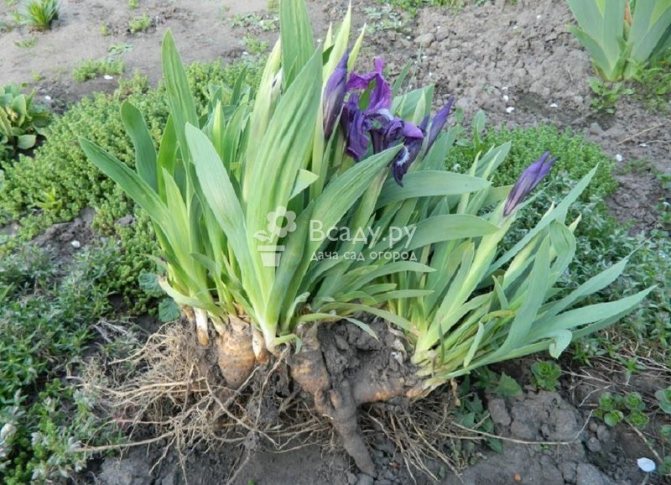

In the fall, caring for irises after flowering consists in carefully covering them with fallen leaves or pine branches (spruce branches) before the onset of cold weather. Such insulation is removed immediately after the last spring snow has melted. This is especially necessary for one-year-old plants, since adult plantings tolerate frost much better.
Fertilize the soil after the top layer has dried. By introducing mineral additives, the earth must be loosened by 1-2 cm in depth, trying not to damage the rhizomes, since they tend to be near the surface.
Many budding florists are wondering when to prune irises after flowering. After the color has fallen, there is no need to cut the leaves, but the peduncles must be broken out under the base of the bush. Half of each leaf must be cut off at the onset of the first cold weather, so that the plant strengthens the roots, and this procedure is also performed when planting.
We suggest you familiarize yourself with: When to chop cabbage for the winter
Top dressing
Hybrid varieties that have reached 3-5 years of age are fertilized as follows:
- In the spring, use mineral supplements consisting of nitrogen, phosphorus and potassium. The proportions are 2: 1: 1.
- At the time of bud formation, the same composition is introduced, only with nitrogen and potassium parts increased to 3.
- 3-4 weeks after the end of flowering, only potassium-phosphorus fertilizing 1: 1 is used.
Three of these approaches will help make plants more attractive and hardy. The deficiency of nutrients has an extremely unfavorable effect on the development of the plant - the formation of a flower ovary and the active growth of new shoots. When properly fertilized, irises are sure to give great color next season.
If during the first planting of the plants, fertilizing was already used, then in the summer there is no need to repeat the procedure.
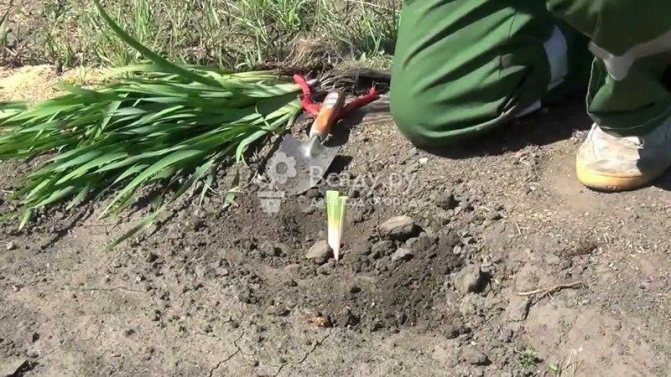

A properly planned plot is already half the success when breeding irises. In the event that the groundwater comes too close to the surface, the soil must be provided with a layer of drainage material, and it is even better to raise the flower bed itself to a height of 15 cm. There must be enough sunlight in the planting site, because irises do not like shadows and are bad bloom in such conditions.
- Siberian irises and Kempfer's variety - 10 years after planting;
- Hybrid varieties and breeding subspecies - after 5.
Many gardeners love to grow irises on their plots. The flower is incredibly decorative, it has many shapes and colors. However, in order for it to please for many years, proper care and pruning is needed.
How to split irises
Correct planting and division is important for these plants. But for what purpose is a transplant required? These flowers can easily grow in one place for 4-5 years. Then the roots grow so much that the soil becomes cramped. The flower beds begin to wither, they hardly bloom. There is a sharp lack of mineral and nutrients. Of course, there are plants that can grow in one place for up to 10 years. These include Siberian irises. But still, most are not adapted to such conditions, so transplanting plays an important role in iris.
Transplanting irises in autumn
One of the fastest ways is to transplant with a clod of earth, but there are some nuances here. Such operations will take place only with young flowers, since their roots have not yet had time to grow.
For your information! But with large plants, this trick will not work, you can simply damage the roots when digging up. In order not to face such a problem, it is recommended to evaluate the root system in advance.
Step-by-step transplant using the root division method:
- Dig up the bush completely, while being as careful as possible, without damaging the root system.
- Clear the roots of the bush from the ground. Then slowly divide it into larger pieces.
- With the help of special sharp tools, divide the roots even more (up to one or two accrete links).
- Too mature or rotten parts of the rhizome must be cut off.
- Thoroughly clean the black roots (cut off as a last resort).
- Hold the final parts of the bush in a fungicide. This solution is capable of disfiguring the surface from diseases.
- Prune the leaves (15 cm high). Fan-shaped is preferable.
- Transplant the plant into soil.
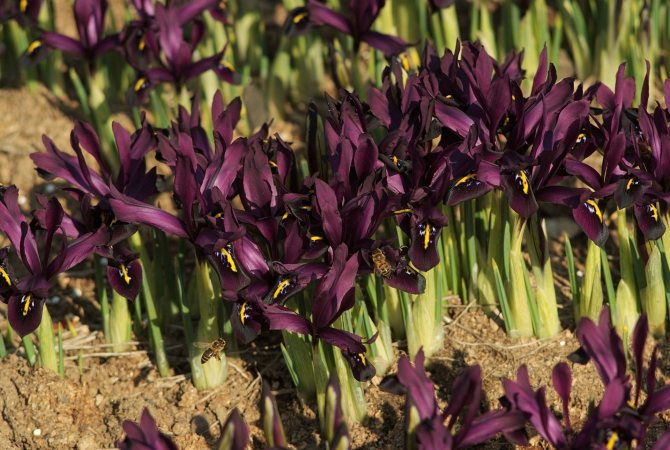

Irises in autumn
This is not all. Gardeners recommend that you familiarize yourself with the features of planting roots:
- Dry the treated roots. More remarkable a few days before disembarkation.
- You can transplant this culture immediately after flowering. It doesn't depend on the season. This is mainly summer and the first month of autumn. At this point, the roots are usually already strengthening.
Preparing irises for winter
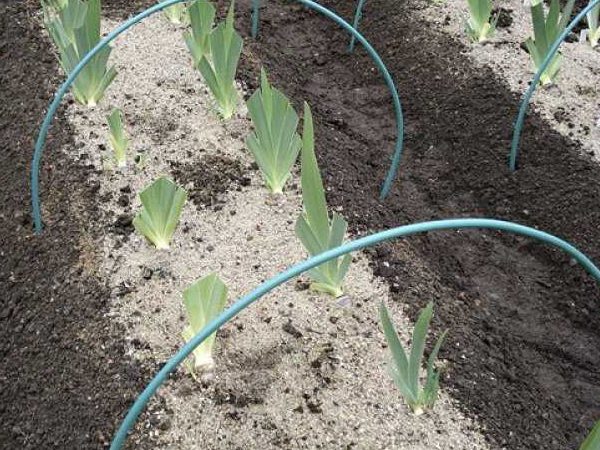

Preparing irises for winter: shelter
Pruning is just one of the activities to prepare plants for winter.
Watering
Irises, like all rhizomes, do not like moisture stagnation. Therefore, watering is stopped by the fall. Experienced flower growers protect flowers from rains with a film in a damp autumn so that the soil does not become waterlogged.
Advice! In the fall, it is not recommended to loosen and weed the plants, so as not to disturb their root system.
Top dressing
These flowers are fed once a month during the growing season using complex fertilizers. But after the middle of summer, nitrogen must be excluded from them. At the very beginning of autumn, fertilizing with phosphorus and potash fertilizers will be beneficial. It will increase the frost resistance of irises. You can use dry fertilizers: 1.5 tbsp. tablespoons of potassium sulfate and 3 - superphosphate. Gently sprinkle this amount over 1 sq. m and close up with loosening. In dry autumn, it is easier to dilute the fertilizer in water, as indicated in the instructions, and pour it onto the same area.
Site selection and soil preparation
Most suitable for flowers such as irises are soil containing a little clay and sand (loam). Clay perfectly moisturizes the composition, and sand makes it lighter and adds looseness. Add peat to add lightness.
But as for the location, it is recommended to land on a well-lit and warm side. Irises don't like shade.
Important! Irises will feel great in the garden, on the site, but they will not take root in the city house. Conditions are too different.
When disembarking, you should prepare the site. Irises should be planted at a low elevation. They cannot be planted in pits. The rhizome edge should protrude 5 mm. They do this so that it warms up thoroughly and does not rot. This is the key to healthy kidneys in the future.
Preparing for planting iris in open ground
After reading the above, it becomes clear that most often irises are transplanted at the end of summer.How to properly prepare the future soil and the flower itself?
The flower should be carefully trimmed. As mentioned, once a week.
Important! You must stop feeding one month before the transplant.
It is worth slowly introducing fertilizers into the soil. For example, ash (2 cups), a bucket of humus, superphosphate (about half a cup), and a bucket of sand. Then dig everything up. Sprinkle with water periodically. Such soil will serve as an excellent basis for a new flower bed of irises.
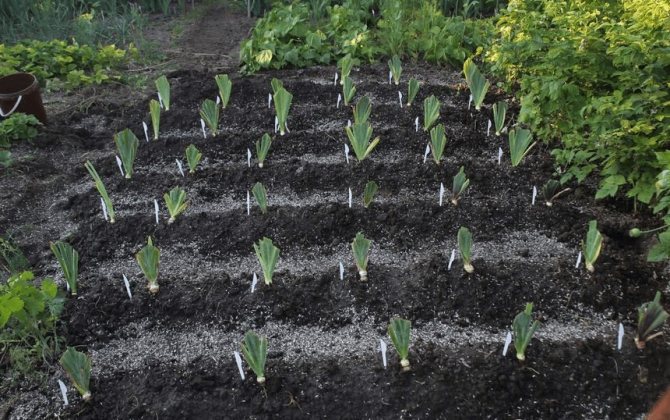

Soil for iris
Preparing pits for irises
You need to dig a hole. The hole should be free, slightly larger than the rhizome. Then pour some sand on the bottom. Place the plant inside. Spread out the roots carefully.
The distance between the bushes must be respected. It should be at least 30 cm. Ideally, 50 cm. Thus, the flowers will definitely not interfere with each other. Then the flower bed should be slightly raised. After all, irises are advised to grow on the hills.
Do irises need a transplant in the fall
Irises are considered frost-resistant plants. Therefore, they can be transplanted in the fall. Experienced florists recommend doing this no more than once every five years.
Why transplant? Over time, the bushes grow strongly, the root system is gradually displaced outward, the number of flowers decreases. Growing stems do not allow each other to develop normally. Therefore, a transplant is carried out, which usually occurs at the beginning of autumn, when they have faded. If flowers are transplanted too late, they will die in the first frost.
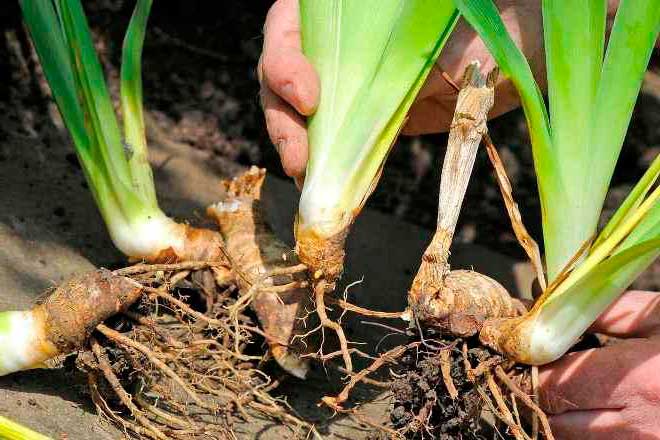

How to transplant irises
First, they prepare the land on the site. It is dug up, loosened, mineral fertilizers are added. It is better not to use organic fertilizers, irises are not very fond of them.
The root system of irises consists of several links with their own roots and a fan, which are interconnected by thin bridges. Having dug a bush out of the ground, you need to carefully divide the roots to get several bushes, the roots of which will consist of 1-3 links.
It is necessary to remove all damaged parts of the roots, the remaining foliage. The bushes prepared for transplantation are dipped in a potassium permanganate solution. After half an hour, they take it out and dry it. The sections are treated with coal powder. Thus, the roots are disinfected.
The bushes are placed in pre-prepared pits. They should be at a distance of half a meter from each other. Do not deeply bury the iris bushes. The top of the root system should remain flush with the soil. After transplanting, the plants need rare watering, so they will take root faster.
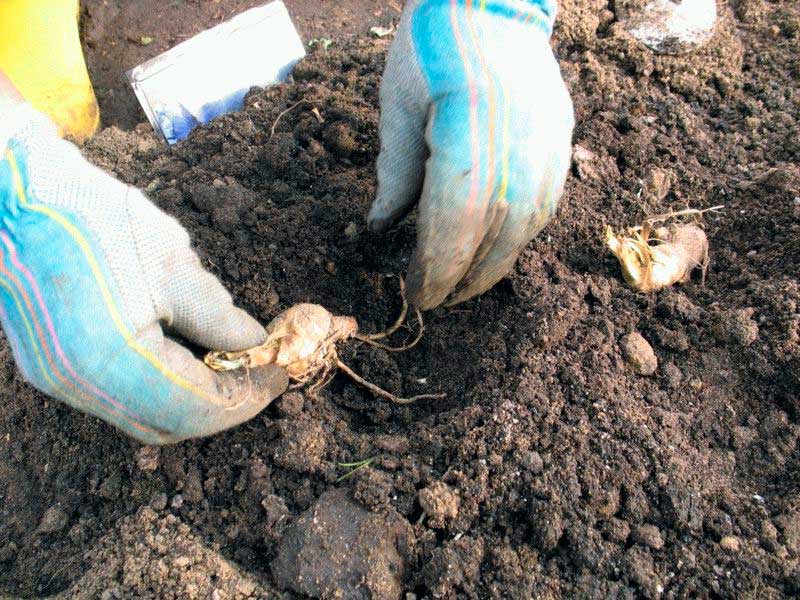

How to arrange iris combs
It is necessary to dig a bed 80 cm wide. It is also allowed to dig a few, but observe the distance between them. Next, take a rake and make a long slide with a small depression in the middle. Then pour water over, let stand and absorb.
Next, you need to calculate the time that the flowers will spend in the combs. If it is 1-2 years, you can leave a space between the plants 20-25 cm. If a longer period of time is planned, the distance increases. Because irises require a wide area for root growth.
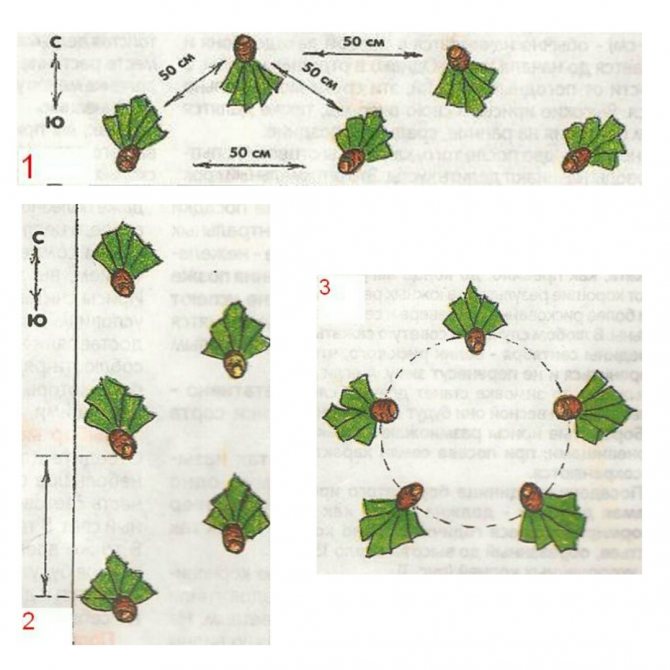

Landing patterns
Landing patterns
There are many different planting patterns now. Only the most suitable for irises are listed here. The peculiarities of their structure must be taken into account, not forgetting that their growth occurs in breadth.
- "Chess". The meaning of the seating is that you need to plant flowers alternately, maintaining a minimum distance of 40-50 cm.
- "In pursuit". The main feature is that all flowers are planted in one direction, forming a beautiful pattern with leaves. Distance 30-45 cm.
- "In a circle". The plants are planted in a circle. In this case, the required distance is only 30 cm (in diameter).
With proper care and attention, irises can create an extraordinary composition in a flower bed. They look bright and light.
Note! With a correctly chosen planting scheme, they are beautifully combined with poppies, lilies, peonies and ornamental shrubs. The dacha will undoubtedly be transformed in their presence.
general information
In nature, irises are represented by a huge variety of species, of which there are more than 800. From the Greek language, the name of this amazing flower is translated as "rainbow". This is due to the fact that this culture has inflorescences of any color range. Iris is a perennial flower that is distinguished by thick, branching rhizomes and bulbous roots. It is easy to recognize by its erect leaves and large flowers, which are distinguished by their unusual shape and bright color. Today, iris grows almost all over the world.
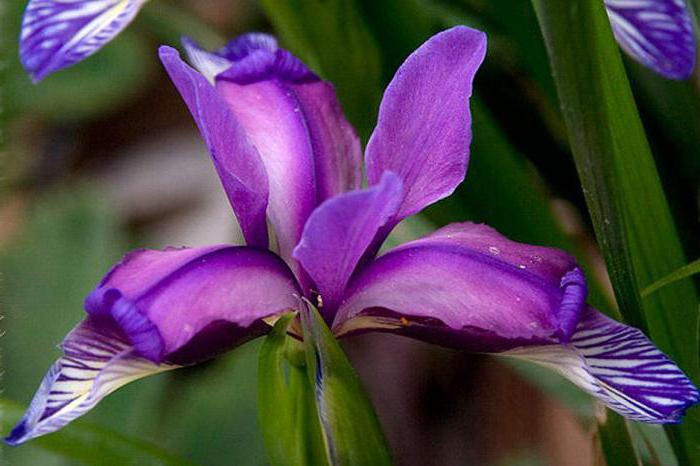

Shelter for the winter
Planted plants should be covered with a layer of peat or ordinary earth. This should be done only at a stable temperature of 4-5 ° C before the first frost. In extremely cold conditions or snowless winters, it becomes necessary to cover the flower beds. For example, dry spruce branches or leaves will do.
The main thing is to open access to fresh air in the spring after the snow melts, when the plants enter the active growth phase.
Thus, this culture is not whimsical, does not require special care. However, in order for the flowerbed to only become more magnificent, some rules should be followed. Then the flowers will delight the gardener's eye again and again.

